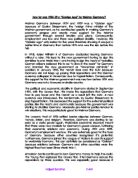This ‘Golden Age’ of the Weimar Republic also saw new innovative techniques in industry and Fordism seized the country. This mass production process was more efficient than in Britain and “by 1929 Germany had become the world’s 2nd industrial power behind United States” (Bookbinder). Despite this increased production there was no enlarged volume in foreign trade so, even with consumer demand filling part of gap, mass production was not entirely useful. Real wages and standard of living both rose in this ‘Golden’ age. But the increased income only paid for the higher cost of the raised standard of living - it did not add to the depleted capital caused by hyperinflation. Despite this industrial modernisation, agriculture remained largely unaffected as there was no modernisation or investment. This probably contributed to the feeling of discontent in the rural areas that compelled many to support anti-Republic parties. The Young Plan to rearrange reparations payments, although passed in 1930, met stiff resistance along the way. It sparked a resistance movement over the ‘Freedom Law’ which demanded the evacuation of all allied powers. Nevertheless the Young Plan was passed and so can be seen as a triumph for the Weimar Republic. Another triumph for the Republic was that unemployment fell from 2 million in 1926 to 1.4 million in 1928. However as the economy slipped into depression in 1929 the figure quickly rose again to 1.9 million.
Despite dwindling support for the extremist parties the picture of Weimar Politics was not rosy. In 1924 the SPD, the largest single Reichstag party, refused to serve in any coalition containing DNVP members. Thus, whether the coalition contained DNVP or SPD parties determined whether it represented the moderate right (bourgeois bloc) or the left. The left-wing coalitions worked in agreement over foreign policy but were fractured over domestic policy where a majority vote in the Reichstag was needed to bring in new legislation. The Bourgeois Bloc also disagreed over foreign policy as well, with the DNVP opposing Stresemann’s policy of ‘détente’ in Europe. The SPD caused further problems by moving politically towards the left, gaining stronger trade union connections with the consequence of more costly welfare policies. This may have been the reason why General Hindenburg decided not to accept the SPD in to his coalition government when he was elected to the Presidency owing to a split anti-right vote. The election of Hindenburg itself raised problems. He disliked the Weimar Republic, and the cultural change it was causing, and had right-wing tendencies which later brought about the rise of Hitler to power in the Reichstag, in the 1930’s. The volatility of the Republic is demonstrated by the collapses of many coalitions in period, many of which were over ideological disagreements.
The Nazi party’s vote failed in the 1926 elections but was it merely consolidating its power ready to pounce on any chance that came its way? Membership in the party increased in this period when it took on a policy of legality. To try and dismiss the view that the Nazis were a thuggish party the SA were more restrained. The party also gained important national exposure when it joined in the campaign for the ‘Freedom Law’, at the same time reorganising itself, adopting the FuhrerPrinzip and replacing unsuitable Gauleiters. Right-wing successes were increased with the releasing of the Lambach Article in 1928, with the DNVP saying the party should forget reviving monarchy and become strongly pro-Republic. This led to a fall in support down from 20.5% (1924) to 14.2% (1928). This downturn in election results led to a leadership change with Alfred Hugenberg taking control. His anti-democratic approach pushed the DNVP yet closer to the NSDAP
The new Weimar cultural flourished in the period 1924-1929 but it ultimately led to deep cultural divisons which reflected both political and social standpoints.
The culture was certainly creative, with its abstract arts movements, the bauhaus architecture movement, new literature with its social commentary (e.g. All Quiet on the Western Front), and different music, e.g. Schoenberg. However, rifts were caused such as the popular escapism of fantasy cinema ( e.g. Charlie Chaplin) which conflicted directly with the Neue Sachlichkeit movement, the latter emphasising the harshness of reality. In this, the connection between the new culture and the Weimar Republic undermined the Republic, forcing many traditionalists towards radical right-wing parties which now had a leverage that could be exploited. Also, rural areas were left unaffected by this cultural shift and so felt alienated from the Republic. The lax views created by the Weimar Culture such as the attitudes to women being allowed to work caused political differences. The Nazi party also tried to infiltrate society with its Nazi groups and professional bodies were formed such as the Hitler Youth or Association of National Socialist Jurists.
To conclude, the period 1924-1929 did mark a ‘Golden Age’ for Weimar Culture, however this had a negative effect on the Weimar Republic through its destruction of ‘traditional’ values. Despite there being no radical political action the situation was still tense and unstable with weaknesses of the Republic being exposed and the radical right gaining more power. Also, although the economic situation could be perceived as calm, long-term problems were created for the Republic which would plague it in latter life. In short, the extent to which the period represented a ‘Golden Age’ for the Republic could be described as short-term. Perhaps the period of calm could have been used to alleviate and halt long-term problems rather than exacerbating them.







